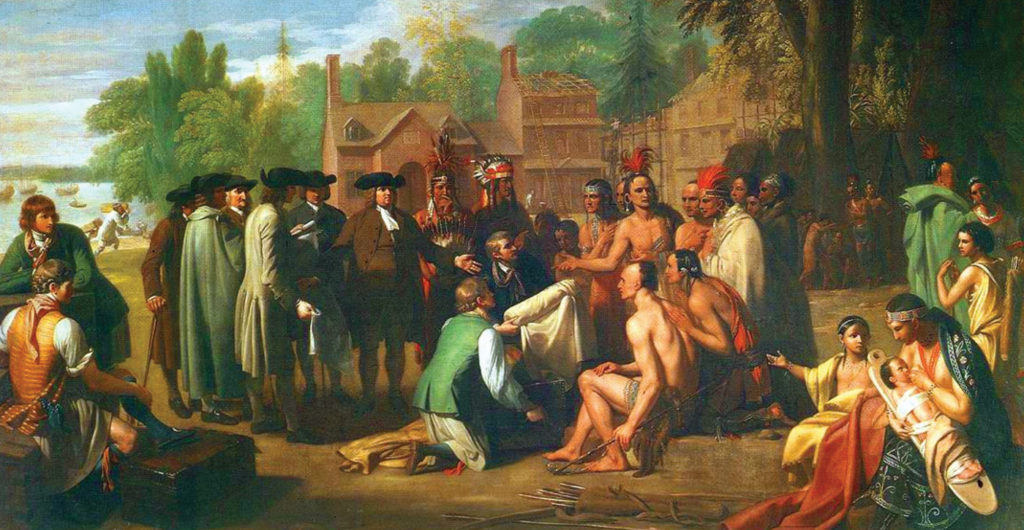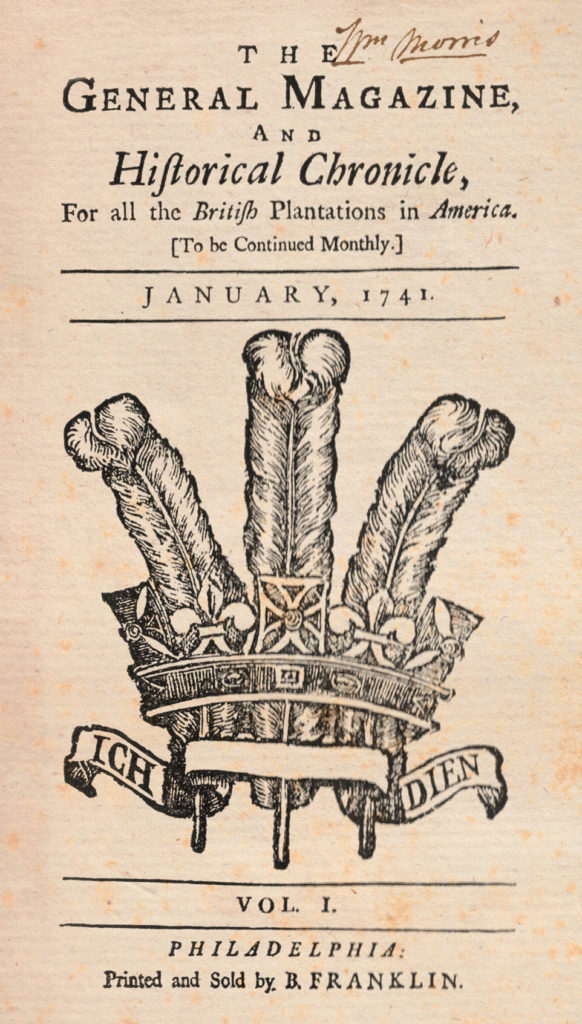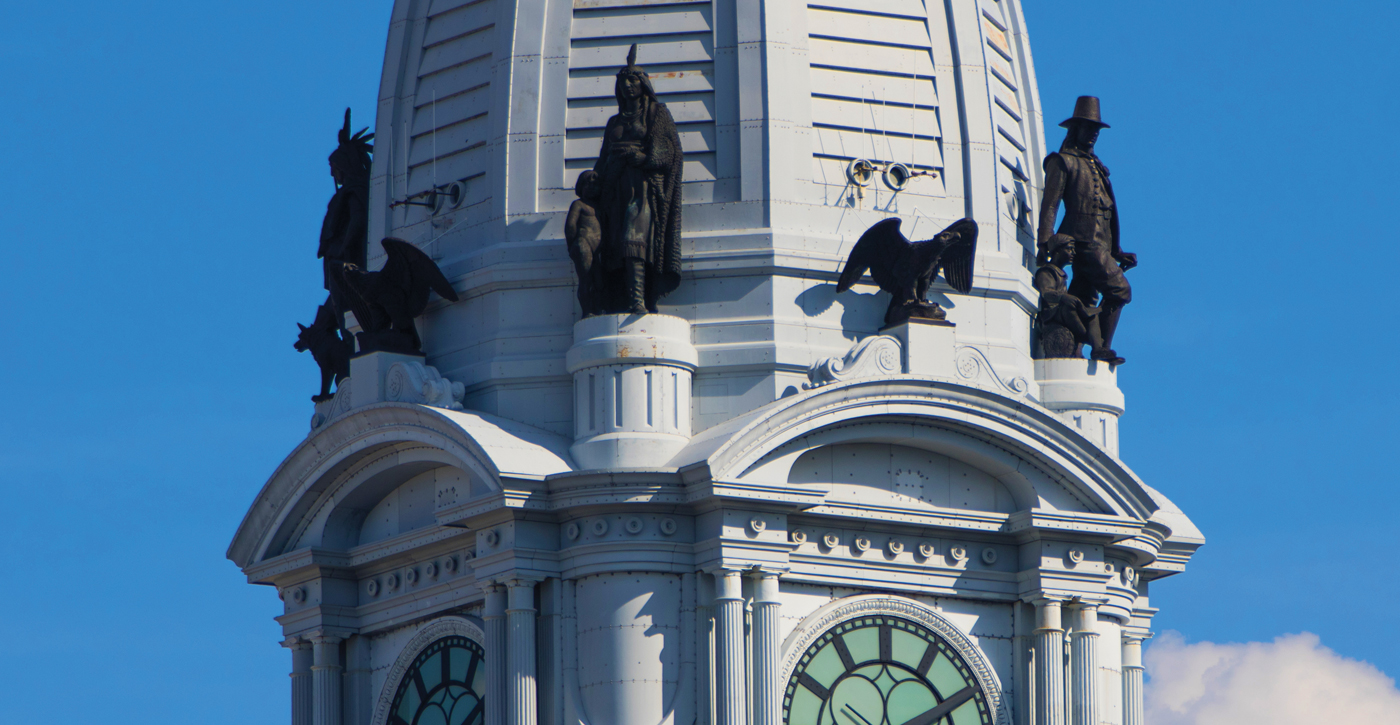How George Fox, William Penn, and Benjamin Franklin Approached North America’s Indigenous Tribes
Current ideas about how George Fox, William Penn, and Benjamin Franklin thought about and dealt with North American tribes need radical revision. For more than three centuries, William Penn has been mistakenly celebrated as a benefactor of tribes. In contrast, Benjamin Franklin is routinely denounced for having referred sardonically to “ignorant savages”—even though he insisted his fellow colonists were far worse. Regrettably, George Fox’s early tribal encounters have attracted little notice, pro or con. Fox should be honored for his determination to seek evidence that Indigenous Americans possessed the Light Within, as well as for the genuine delight he displayed when he found such evidence.
George Fox was 25 in 1649 when his country’s Christian king was beheaded by Christians. All around him, Fox saw Christian governments killing people for professing supposedly wrong Christian beliefs. He finally decided that the time had come to start living by basic Christian values rather than trying to force-feed a particular Christian dogma. A craftsman without a scholastic education, Fox drew his understanding of the world’s history and people directly from the Bible. He believed all the world’s people were descended from Adam and Eve, and that all the world’s cultures contained some approximation of Jesus’s Golden Rule: that you should treat others as you would yourself hope to be treated.
Resolving to carry this message across the Atlantic, Fox set out in August of 1671. In the Caribbean, Fox preached to enslaved Africans and Indigenous Americans. Afterward he remarked, “there is something in them that tells them . . . they should not practise . . . evils.” Reaching the North American continent in April of 1672, Fox spent the next 14 months traveling through what is now North Carolina, Virginia, Maryland, Delaware, Pennsylvania, New Jersey, New York State, and Rhode Island. He journeyed overland with “two Indians to be our guides” from Maryland to Long Island, and spent one night in the house of “an Indian king . . . and . . . his queen . . . [who] received me and laid me on a mat for a bed.” Fox met with Quakers, argued with Christian clerics, and discussed ethics with tribal groups. While visiting the governor of a small province later folded into North Carolina, Fox was accosted by a learned cleric who insisted that preaching to heathens was a waste of time. Fox recalled in his Journal:
I called an Indian and . . . asked him if . . . he did lie and do that to another which he would not have them do the same to him, and when he did wrong was not there something in him, that did tell him of it, that he should not do so, but did reprove him. And he said there was such a thing in him when he did any such a thing that he was ashamed of them. So we made the doctor ashamed in the sight of the governor and the people.
Convinced that Indigenous American societies possessed approximations of the Christian Golden Rule, Fox deplored attempts at forcible religious conversion, and advocated instead neighborly interchange of views with members of self-governing tribes. In Rhode Island, he conversed with a tribal leader who criticized the Puritans’ insistence that converts must fully and formally renounce all their “heathen” ways. Fox’s informant lamented that “there were many of their people of the Indians turned to the New England professors. He said they were worse since than they were before they left their own religion.” Alternatively, if tribal members “should turn to the Quakers, which was the best, then the [Puritan] professors would . . . put them to death and banish them as they did the Quakers, and therefore he thought it was best to be as he was.”
Fox found no fault with this logic. Indeed, after traveling overland to Long Island, he had reached Rhode Island by boat, bypassing Puritan Connecticut, and declined to press on into Puritan Massachusetts, where 12 years earlier the Quaker Mary Dyer had been hanged on Boston Common. Three years after Fox’s 1672 visit to Rhode Island, the disastrous King Philip’s War broke out.

The Treaty of Penn with the Indians by Benjamin West. Pennsylvania Academy of Fine Arts, Philadelphia, Pa.
Instead of holding treaties with tribes to explain the conditions of their tolerated tenancy, Penn could have given them affirmative, legally recorded land grants, as he did for example to George Fox in absentia.
Twenty-six-year-old William Penn was among those seeing Fox off when he departed England in August of 1671, and was also among those welcoming Fox home when he returned two years later. Twenty years younger than Fox, Penn considered Fox his mentor, and shared his hopes that North America could become a safe haven for Quakers and other compatible groups. In 1673, Penn was drawn into plans for a Quaker-oriented West Jersey colony. Eight years later came a royal grant to Penn of roughly 45,000 square miles situated immediately west of West Jersey.
Although Penn and Fox did respectfully collaborate, their differing class backgrounds had large consequences. Penn’s father, Sir William Penn, was one of England’s richest and most powerful men, and the rebellious younger William Penn retained many aristocratic characteristics. George Fox could see that North America’s tribes were highly structured, complexly organized societies, and spoke admiringly of his conversations through interpreters with tribal emperors, empresses, kings, queens, councillors, and nobles. In contrast, William Penn viewed all members of tribes, including their leaders, in much the same way he viewed his “wild” Irish tenants. Penn imagined tribes were loosely organized bands casually led by persons he labeled “half-kings.” Ordinary members of tribes he described patronizingly as “the most merry creatures that live, [who] feast and dance perpetually.” His royal charter granted by England’s Stuart King Charles II commended Penn’s intent to “reduce the savage Natives by gentle and just manners to the Love of Civil Societie and Christian Religion.” In Penn’s eyes, all members of Pennsylvania’s Indigenous tribes were targeted for reduction to the status of inoffensive tenants. Any “savage Natives” who disdained reduction would be pressured to move west.
For centuries, Penn has been praised for entering into treaties with tribal groups. The first and most famous such treaty supposedly occurred in 1682 under a huge elm tree beside the Delaware River in what became Philadelphia. Although the word “treaty” can connote a formal contract negotiated between governments, it can also mean nothing more than a disparate gathering to discuss issues of mutual concern. In this latter sense, Penn did hold treaties in which he informed tribal members of the conditions of their new status as non-rent-paying tenants. As a Quaker landlord, Penn wanted to be fair and open. He therefore desired to meet face-to-face with persons conditionally permitted to reside rent-free on his valuable land. Penn’s treaties were meant to clarify where and in what way tribal tenants could peacefully remain, in hopes that they would not obstruct his plans to sell off surrounding lands to rent-paying purchasers. Pursuant to his royal charter, Penn believed he now owned the lands long occupied by Pennsylvania tribes. Nonetheless, as a goodwill gesture, he was willing to offer them modest presents for acknowledging that he was indeed their rightful landlord.
Instead of holding treaties with tribes to explain the conditions of their tolerated tenancy, Penn could have given them affirmative, legally recorded land grants, as he did for example to George Fox in absentia. A 1,250 acre grant to Fox was entered in Pennsylvania’s land records, unlike Penn’s vague promises to illiterate tribes. In colonies adjoining Pennsylvania, formally recorded land grants were in fact made to tribal groups. A New Jersey tribal land grant ended up becoming the subject of an 1812 U.S. Supreme Court case, New Jersey v. Wilson, with an opinion by Chief Justice John Marshall. In addition to his grant to Fox, Penn himself made two large grants of land to non-English-speaking, self-regulating groups: one for Welsh speakers and another for German speakers. Similar grants could have been made to Pennsylvania’s self-governing tribes.
If Penn had settled down in Pennsylvania and spent decades living at Pennsbury Manor as planned, he might have done more for his vulnerable tribal tenants. Instead he felt obliged to return to England to engage in legal battles over boundaries with adjoining colonies. After the Glorious Revolution of 1688, he remained in England to deal with the consequences of the overthrow of his Stuart patrons. Penn’s personal interactions with tribes were therefore limited. But the long-range impact on tribes of the Penn family’s proprietorship was to prove devastating. Many tribal communities were forced west, where they allied with England’s French enemies, determined to reclaim ancestral lands by force.
Franklin steadily maintained that tribes were coherent polities with reasonable concerns about land rights and fair trade practices that must be seriously addressed.
Beginning in the 1730s, a penniless interloper named Benjamin Franklin resolved to stand up to Penn’s heirs on behalf of tribes, and to halt the drift toward what came to be known as the French and Indian War. Franklin’s understanding of tribes was shaped by the failure of Pennsylvania’s tribal policy, and also by the fact that through laborious self-education he came to believe that the world contained more than one valid culture and more than one type of legitimate government. No less than the Chinese and Persians, tribal Americans possessed ancient cultures and viable modes of governance. “Savages we call them,” Franklin argued, “because their manners differ from ours, which we think the Perfection of Civility; they think the same of theirs.” Discussing the intertribal mode of governance that the Iroquois Confederacy had evolved over centuries, he remarked:
It would be a very strange Thing if six Nations of ignorant Savages should be capable of forming a Scheme for such an Union, and be able to execute it in such a Manner, as that it has subsisted Ages, and appears indissoluble; and yet that a like Union should be impracticable for ten or a Dozen English Colonies, to whom it is more necessary and must be more advantageous; and who cannot be supposed to want an equal Understanding of their Interests.
Franklin was here shaming his fellow colonists in order to rally them into forming their own multi-colony alliance, a goal only accomplished decades later through revolution.
Because he admired the way the Iroquois Confederacy resolved intertribal tensions through regular treaty conferences, Franklin began publishing speeches made by tribal leaders at such conferences. His rationale is often said to have been fondness for their literary metaphors (for example, the description of God as “Master of Breath”). But Franklin also had a more down-to-earth motive for publishing these proceedings, hinted at by the fact that he sent copies to London. Franklin was determined to counter Penn family propaganda that Pennsylvania’s “ignorant savages” could be safely ignored.
After publishing numerous tribal treaty transcripts, Franklin was himself asked to serve as a Pennsylvania Treaty Commissioner. On October 2, 1753, Franklin and his two fellow commissioners opened negotiations at Carlisle, Pennsylvania, in accord with tribal custom by presenting a ceremonial belt of wampum beads depicting “Figures . . . holding one another by the Hands.” This belt, an interpreter explained, portrayed Pennsylvania’s tribes and Euro-American immigrants “linked in a close and firm Union.” The belt was made of countless separate beads threaded onto leather thongs, and therefore, warned the interpreter:
In whatever Part the Belt is broke, all the Wampum runs off, and renders the Whole of no Strength or Consistency. In like Manner, should you break Faith with one another or with this Government, the Union is dissolved. We would therefore hereby place before you the Necessity of preserving your Faith entire to one another, as well as to this Government.
Proceeding to business, a tribal spokesperson complained that a scarcity of gunsmiths made “mending” hunting rifles difficult. Also he stated:
Your Traders now bring scarce any Thing but Rum and Flour. . . . They bring little Powder and Lead, or other valuable Goods. The Rum ruins us. We beg you would prevent its coming in such Quantities, by regulating the Traders.
The following day, Franklin and his fellow commissioners replied, noting with concern:
your Observations on the Indian Traders, and the loose straggling Manner in which that Trade is carried on. . . . Your Proposals to remedy this, by having named three Places for the Traders to reside in, under your Care and Protection . . . have made a very strong Impression upon our Minds.
After this substantive meeting, Franklin and his fellow commissioners recommended that Pennsylvania’s Penn family governor implement these pragmatic proposals, and warned that:
unfair Dealings . . . will, it is to be feared, entirely estrange the Affections of the Indians from the English . . . and oblige them either to abandon their Country, or submit to any Terms, be they ever so unreasonable, from the French.
A year later at Albany, New York, Franklin tried again without success to avert the looming French and Indian War by urging British colonies to adopt a united and conciliatory stance toward tribes. After this avoidable war, Franklin switched tactics and sought to persuade England’s king to end the Penn family’s proprietorship. When this tactic also failed, Franklin finally threw his support behind the colonies’ effort to end royal rule altogether. Throughout these twists and turns, Franklin steadily maintained that tribes were coherent polities with reasonable concerns about land rights and fair trade practices that must be seriously addressed.

Franklin’s The General Magazine and Historical Chronicle (January 1741)
If Benjamin Franklin and George Fox approached tribes with discernment, and William Penn’s tribal policies were disastrous, why is Penn today seen as having been a paragon in his dealings with tribes? A key reason is that after Franklin went to England in 1757 to persuade King George II (and then King George III) to abolish the Penn family’s proprietorship, William Penn’s heirs commissioned a still-admired propaganda piece by one of London’s leading artists, Pennsylvania-born Benjamin West. Completed in 1772, West’s painting of William Penn beneath Philadelphia’s “Treaty Elm” graciously befriending his new tribal tenants (housed today in the Pennsylvania Academy of the Fine Arts) failed to save the Penn family’s proprietorship from being swept away in the American Revolution. West’s painting nonetheless later became the inspiration for dozens of popular folk paintings by the Quaker artist Edward Hicks, a cousin of Elias Hicks who was the namesake of the Hicksite Quakers.
Hicksite Quakers are justly admired for their efforts to abolish slavery and end racist abuse of tribes. To further this good work, William Penn’s image was zealously refurbished. Because the original purpose of Benjamin West’s admired painting was now forgotten, William Penn became for nineteenth-century Pennsylvanians a person worthy to dwell with tribes in the Garden of Eden, along with the cherub, the lion, and the lamb. Next came Penn’s 1894 elevation to the top of Philadelphia’s City Hall, where below him stand an awed Indigenous American and a thankful immigrant woman and child.
William Penn did make important contributions to Pennsylvania, including his spacious street plan for Philadelphia and his tolerance for multiple Christian sects. Ironically, the initiative for which he is today most often praised––his tribal policy––was a disaster. In contrast, although often attacked as anti-tribe, Benjamin Franklin supported reform proposals made by tribal leaders. Like George Fox, whose pro-tribe efforts remain little known, Franklin believed tribes could be worthy neighbors.




Such an interesting article about Fox, Penn, and Franklins attitude towards Native Americans. The Hicks painting is misleading. And I love the Peaceable Kingdom
Great article! I hope this corrected version of events will spread throughout the Quaker world.
One quibble: Hutchins says, “Hicksite Quakers are justly admired for their efforts to abolish slavery and end racist abuse if tribes.” Here in Ohio, much of the antislavery work was done by so-called “orthodox” Quakers, the most well-known being Levi & Catherine Coffin, who worked alongside Presbyterians and Hicksite Quakers on the Underground Railroad. After the Civil War, President Grant appointed Quakers, many of them “orthodox,” as tribal agents to counter mistreatment of indigenous people by military agents.
Being “tribal agents” as you call them, or really “Indian agents” as they are actually known, is nothing to be proud of. They were Quakers carrying out a policy of genocide for the US government, attempting to “civilize” indigenous peoples by destroying their culture, civilization, traditional knowledge and ways, so that they would no longer fight for their land or rights. As president Grant told Friends at that time: “make Quakers out of the Indians, it will take the fight of them.”
yes ….life is sufficient… without respect, neither with disrespect to empire.
I so appreciate the information about my cousin, Benjamin Franklin. When my great-grandparents met at a Quaker meeting in around 1890, they each had half of the story of “Uncle Ben’s” friendship with Skenandoah, an Oneida leader. My great-grandmother, Sarah Mariah Leonard, was first cousins with Uncle Ben 4 different ways. My great-grandfather, Oliver Perry Underwood, learned the Oneida oral history through his (adopted) grandmother, Skenandoah’s granddaughter. My mother, Paula Underwood, self-published this story and called it Franklin Listens When Speak.
When the writer says:
“Hicksite Quakers are justly admired for their efforts to abolish slavery and end racist abuse of tribes..” what is meant by “end racist abuse of tribes”? Is this a reference to the Era when Friends participated in genocide against indigenous peoples by becoming Indian agents and building genocide schools? There is nothing admirable about that.